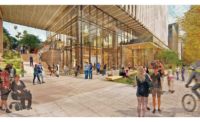Though sustainability, modular construction and team collaboration dominated the news in the buildings sector in 2012, green building seems to be the topic most talked about. Every few weeks, it seems, green-building promoters issue guidance, model codes and digital tools to advance sustainable design and construction. Some say that green-regulation compliance is burying project teams in paperwork. Even worse, in a buyer’s market, owners keep dreaming up ways to put their design and construction teams at risk if the buildings do not meet energy targets. Though there has been some progress toward eco-friendly development, almost all green-building enthusiasts agree that true sustainability is a long way off.
The topic can stir controversy. Disagreements over the proposed fourth version of the U.S. Green Building Council’s popular rating system, called LEED, started to boil over this year and culminated in an unprecedented fifth public comment period on the latest draft, called LEED v.4. USGBC also delayed the ballot until this coming June.
 |
Last July, opponents of LEED v.4 formed the American High-Performance Buildings Coalition. The group wants green-building codes, standards, rating systems and credits developed in conformance with "full ANSI- or ISO-type consensus processes." It also wants LEED credits based on data supported by science and performance-based, not point-based, ratings. LEED certification is based on a point system.
One of the most volatile issues is product ingredient labels, in general, and specifically, LEED credits that discourage use of products with ingredients deemed harmful to humans and the environment. To help calm the waters, USGBC is using part of a recent $3-million grant from Google Inc. to fund research regarding the content of green products and materials.
To aid designers, in March, the International Code Council released the 2012 International Green Construction Code. IgCC hopes the new code will provide more flexibility in high-performance building design than did earlier versions. The update is touted as the first model code to include sustainability measures for an entire construction project and its site—for the entire life cycle of the project.
There is also a green standard for health-care facilities coming. It is out for public review until Jan. 21.
The USGBC also released its first set of data-center certification requirements in an update of LEED 2012. The U.S. market for energy-guzzling data centers is expected to increase to $20 billion by 2020 from $15 billion in 2012.
Data-center design and construction experts have been revving up their efforts to tame the data center’s ravenous appetite for energy. A project for TELUS, which opened in the fall, showcases a new type of energy-efficient cooling system as part of a modular building approach. After a couple of months of operation, the data center is performing better than predicted, says its builder.
Modular building took another leap forward with the groundbreaking of what is touted to be, when completed, the world’s tallest modular high-rise: a 322-ft-tall apartment building at the Atlantic Yards megadevelopment in Brooklyn, N.Y.
At least two owners are asking their design-build teams to put their money where their mouths are, in terms of energy consumption predictions. For the National Renewable Energy Laboratory’s Research Support Facility, the performance-based design-build team did not get fully compensated until the building performed as predicted. For the first year of full occupancy, which ended last February, the 220,000-sq-ft building met its modeled annual energy-use targets, says NREL.



Post a comment to this article
Report Abusive Comment